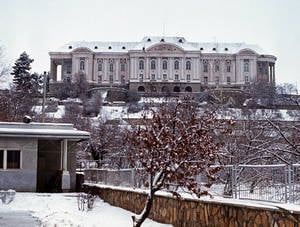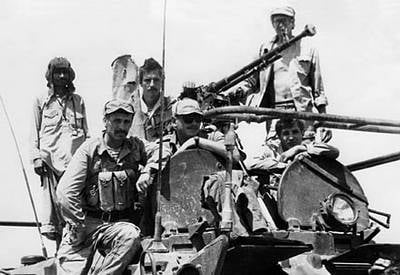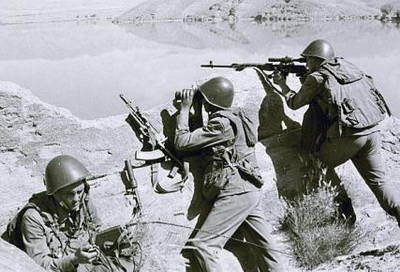Storming Amin's Palace
 27 December 1979 was stormed to take Amin's palace near Kabul. As a result of the special operation, codenamed “storm-333”, Afghan President Hafizullah Amin was eliminated. This operation, the active phase of which lasted about 1 hours, became the prologue of the introduction of Soviet troops into Afghanistan and marked the beginning of a series of local conflicts involving our country at the end of the 20th and beginning of the 21st centuries.
27 December 1979 was stormed to take Amin's palace near Kabul. As a result of the special operation, codenamed “storm-333”, Afghan President Hafizullah Amin was eliminated. This operation, the active phase of which lasted about 1 hours, became the prologue of the introduction of Soviet troops into Afghanistan and marked the beginning of a series of local conflicts involving our country at the end of the 20th and beginning of the 21st centuries.About 650 people took part in the operation to capture Amin’s residence. The Muslim battalion is the 520 man, the Airborne Company, the 87 man and the two special groups of the KGB of the USSR "Thunder" (24 man) and Zenith (30 man) who were to directly capture the palace. The attackers were dressed in an Afghan uniform with white armbands, the “Yasha-Misha” shouting was the identification password.
The Muslim battalion was created from soldiers and officers of immigrants from Central Asia (Tajiks, Uzbeks, Turkmen). During the selection, special attention was paid to physical training, only those who served half a year or a year were involved, the principle of voluntariness lay at the base, but if there were not enough specialists, a good military expert could be enrolled in the detachment without his consent. The squad, which, because of its size, was named the battalion, consisted of a 4 company. The first company was armed with the BMP-1, the second and third BTR-60pb, the fourth company was a company of weapons, it included a platoon of AGS-17 (only appeared in the troops), a platoon of rocket rocket flame throwers "Rys" and a sapper squadron. The detachment had all the corresponding logistical units: platoons for automobiles and software, communications, in addition, the battalion was given a platoon of ZSU Shilka. A translator was attached to each company, but, considering the national composition, their services were almost not used, all Tajiks, half of Uzbeks and some Turkmen knew Farsi - one of the main languages of Afghanistan. The funny thing came out only with the vacancy of the anti-aircraft officer, it was not possible to find the necessary person of the necessary nationality and the dark-haired Russian captain Pautov, who, when he was silent, was not singled out for the total. The detachment was led by Major H. Khalbaev.
The detachment received Afghan uniforms and documents and arrived in Afghanistan at the Bagram base as early as August 1979 of the year. Officially, the battalion was supposed to guard the President of the Democratic Party of Afghanistan Hafizullah Amin, but in fact, the battalion was used in exactly the opposite way. If you call a spade a spade, the leadership of the USSR immediately prepared a battalion for carrying out a coup in Afghanistan with the establishment of the pro-Soviet government. Before that, Afghanistan had already asked for military assistance and appealed to both the USSR and the USA, the USSR leadership decided to go its own way, to render assistance only after the removal of the current leader of the country.

To accomplish this, a company of airborne troops and two special forces detachments were redeployed to Bagram, the formation of which was carried out by the KGB of the USSR. The Zenith squad consisted of 24 people from special group A, which later became known as the Alpha group. The Thunder squad consisted of 30 man officers of the special reserve of the KGB of the USSR. All half divisions involved in the assault were armed with the most modern at the time weapons. So the capture of Amin's palace was the first case of the RPG-18 "Fly". This grenade launcher became widely known, and now the image of a soldier with the “Fly” is firmly associated with the participants of the first and second Chechen wars.
To take Amin’s palace was not an easy task. An infantry brigade consisting of 3 battalions was deployed around the palace, and the palace’s security was further enhanced tank the battalion and anti-aircraft regiment, which was armed with 12 100-mm cannons and a large number of DShK machine guns, given that the palace was on a hill, this artillery could become an insurmountable obstacle for attackers. Directly in the palace was the company of Amin’s personal guard, largely consisting of his relatives. Thus, the forces of the defenders were many times superior to the forces of the attackers.
Operation plan
The plan of operation provided for the seizure of the palace and the destruction of air defense weapons of the anti-aircraft regiment. The remaining units were supposed to block in military camps. For the destruction of air defense weapons were allocated 2 calculation AGS-17 and engineering platoon. The grenade launchers were supposed to cut off anti-aircraft gunners from air defense weapons located in positions, at which time the engineering platoon was to carry them out.
A separate group was to capture the 3 tank dug near the palace. An 12 person has been allocated for this purpose. Two snipers, who were supposed to remove the protection of the tanks, 2 machine gunner, tank crews. They had to drive the GAZ-66 car past the 3 positions of the guard battalion and capture the tanks.
The 2 and 3 companies of the Muslim battalion and the company of paratroopers given to them were supposed to block the location of the battalions of the brigade of the guard and the tank regiment. For the storming of the palace, the first company was recruited, which, on its BMP, was supposed to bring the Thunder and Zenit assault troops to the palace.

Assault
The assault on the palace was carried out in accordance with the plan of the operation, the active phase of the battle lasted about an hour, although the shooting did not stop for another day, some soldiers and officers of the infantry brigade did not want to surrender and fought their way into the mountains. Afghan casualties accounted for about 200 people killed, including Amin and his son, about 1700 servicemen surrendered. Our losses were 19 people, 5 from the KGB assault groups, another 5 lost paratroopers, 9 people lost the "Muslim battalion." Almost all members of the assault groups were injured.
The group left first on the GAZ-66, but when the car drove past the 3 battalion's location, an alarm was already declared in it, a battalion commander and his deputies were standing in the center of the parade ground, the soldiers received weapons and ammunition. The commander of the Sakhat group was not taken aback and decided to seize the leadership of the battalion. The car drove at full speed on the parade ground, the scouts instantly seized the Afghan officers and rushed off. When the Afghans came to their senses, it was already too late. Having driven away, the group lay down on the road and met the Afghan soldiers who had started chasing with fire, attacking the crowd without the guidance of officers, they became easy prey. The snipers of the group at this time destroyed the sentries by the tanks.
As soon as the shooting began at the positions of the 3 Battalion, a general assault began. Two "Shilka" began to work on the palace, another 2 and the calculations of the ACS began to fire at the barracks and courtyards, not allowing soldiers to leave the barracks. At the same time, motor-infantry advanced to block the barracks. And assault groups advanced to the palace on the BMP. Afghans quickly recovered and opened heavy fire at BMP moving along serpentine, they managed to hit the first car, they had to leave the paratrooper and climb the mountain using ladders specially prepared for such an occasion. As a result, the fighting vehicles were at the palace after 20 minutes after the start of the operation, followed by an assault and a battle for each room of the palace, at the same time as the beginning of the assault Shilki were to be silenced, but this did not happen. The communication channel was filled with requests for help from the commander of one of the armored personnel carriers, who fell into a ditch, so for a cease-fire around the palace, the messenger had to be sent to the location “Shilok”. An hour later, President Hafizullah Amin was already dead.
- Yuferev Sergey
- http://topwar.ru"rel =" nofollow ">http://topwar.ru
Information